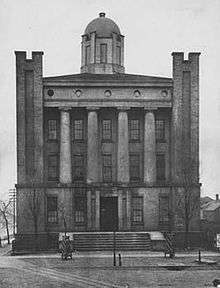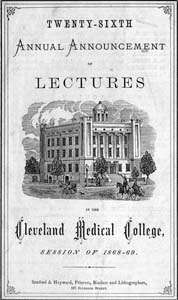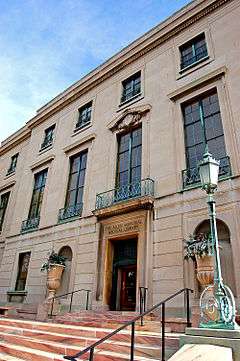Case Western Reserve University School of Medicine
| Type | Private |
|---|---|
| Established | 1843 |
Academic staff | 11,049 |
| Students | 1,206 |
| Location | Cleveland, Ohio, U.S. |
| Website |
case |
 | |
Case Western Reserve School of Medicine (CWRU SOM, CaseMed) is one of the graduate schools of Case Western Reserve University, and is located in the University Circle neighborhood of Cleveland, Ohio. The School of Medicine is among the top 25 medical schools in the United States and is the top-ranked medical school of Ohio in research per U.S. News & World Report.[1] Additionally, Case School of Medicine is the largest biomedical research center in Ohio.[2] In 2015, the average MCAT score for the entering class was 36.
The Dean of the medical school is Pamela B. Davis. Prospective students have the option of three degree paths leading to a medical degree at the School of Medicine: the "University Program" whose origins go back to 1843, the "College Program" at the Cleveland Clinic started in 2002; and the Medical Scientist Training Program (MSTP).
In 2002, the School of Medicine became only the third institution in history to receive the best review possible from the body that grants accreditation to U.S. and Canadian medical degree programs, the Liaison Committee on Medical Education.[3]
History
On November 1, 1843, five faculty members and sixty-seven students began the first medical lectures at the Medical Department of Western Reserve College (also known as the Cleveland Medical College).[4]

The School of Medicine has trained medical students, served the community, and been at the forefront of discovery in the City of Cleveland for over 165 years.

Women in Medicine: In 1852, the medical school became the second in the U.S. to graduate a woman, Nancy Talbot Clarke. 1854 MD alumna, Emily Blackwell became the third woman in the US to receive a regular medical degree. Six of the first seven women in the United States to receive medical degrees from recognized allopathic medical schools graduated from Western Reserve University between 1850 and 1856.
Flexner Survey:
In 1909, Arbraham Flexner, a graduate of Johns Hopkins University surveyed and evaluated each of the one hundred and fifty-five medical schools then extant in North America. The results of his investigation proved shocking: most "medical schools," for example, had entrance requirements no more stringent than either high school diploma or "rudiments or the recollection of a common school education."

Only sixteen schools required at least two years of college as an entrance requirement, and of these, Johns Hopkins, Harvard, and Western Reserve were still the only ones to require an undergraduate degree. Although Johns Hopkins represented his ideal, Flexner also singled out the Medical Department of Western Reserve University for its praiseworthy admission standards and facilities. Flexner referred to Western Reserve as "already one of the substantial schools in the country." In a letter to Western Reserve president Charles Franklin Thwing he said, "The Medical Department of Western Reserve University is, next to Johns Hopkins..., the best in the country."
Western Reserve Curriculum: A little over forty years later, in 1952, the Western Reserve University School of Medicine revolutionized medical education with the "new curriculum of 1952" and more advanced stages in 1968. This was the most progressive medical curriculum in the country at that time, integrating the basic and clinical sciences.
Research History: Development of the modern technique for human blood transfusion using a cannula to connect blood vessels; first large-scale medical research project on humans in a study linking iodine with goiter prevention; pioneering use of drinking water chlorination; discovery of the cause of ptomaine food poisoning and development of serum against it and similar poisons; first surgical treatments of coronary artery disease; discovery of early treatment of strep throat infections to prevent rheumatic fever; development of an early heart-lung machine to be used during open-heart surgery; discovery of the Hageman factor in blood clotting, a major discovery in blood coagulation research; first description of how staphylococcus infections are transmitted, leading to required hand-washing between patients in infant nurseries; first description of what was later named Reye's syndrome; research leading to FDA approval of clozapine, the most advanced treatment for schizophrenia in 40 years at the time; discovery of the gene for osteoarthritis; and creation with Athersys, Inc., of the world's first human artificial chromosome.
Integrated MD-PhD Training: In 1956, CWRU School of Medicine began an explicit M.D. and Ph.D. dual-degree training program. This served as a template for other research medical schools who quickly adopted the idea. In 1964, the National Institutes of Health began to fund some of these programs through its prestigious Medical Scientist Training Program (MSTP). Today, the MSTP trains nearly a thousand students at any given time.
CaseMed Today: Today the CWRU School of Medicine is the largest biomedical research institution in Ohio and one of the largest in the nation, as measured by funding received from the National Institutes of Health. The School of Medicine has eight Nobel Prize holders among its alumni and former and current faculty, and also has graduates who have distinguished themselves as U.S. Surgeons General: Jesse Steinfeld, MD, and David Satcher, MD, PhD, and the current the Director of the CDC, Julie Gerberding, MD.
Notable alumni and faculty
- Shuvo Roy, Professor, Inventor of Artificial Kidney
- Nancy Talbot Clarke (1852 MD alumna)[5] & Emily Blackwell (1854 MD alumna)[6] - second and third women in the United States to earn a medical degree. Six of the first seven women in the United States to receive medical degrees from recognized allopathic medical schools graduated from Western Reserve University (as it was called then) between 1850 and 1856.
- George Washington Crile (1887 MD alumnus) - Performed first blood transfusion. Established Lakeside Hospital of what is now University Hospitals Case Medical Center,[7] and later co-founded Cleveland Clinic.[8] Crile was a graduate of Wooster Medical College which merged to form modern day CaseMed.[9][10][11]
- John A. Rice (1851 MD alumnus) - member of the Wisconsin State Senate.
- Thomas Wingate Todd, Professor of Anatomy
- Matthew N. Levy, Professor of Physiology, co-author of Berne & Levy's Principles of Physiology
Nobel laureates

Alumni
- 1980 - Paul Berg (1952 PhD in Biochemistry alumnus), Nobel Prize in Chemistry for pioneering research in recombinant DNA technology.[12]

- 1985 & 1997 - H. Jack Geiger (1958 MD alumnus), Though not a recipient of Nobel prize directly, he was the founding member and past president of Physicians for Human Rights[13][14] which shared the 1997 Nobel Peace Prize[15] as part of International Campaign to Ban Landmines. He also was a founding member of Physicians for Social Responsibility which shared the 1985 Nobel Peace Prize as part of International Physicians for the Prevention of Nuclear War.
- 1994 - Alfred Gilman (1969 MD-PhD alumnus), Nobel Prize in Physiology or Medicine for co-discovery of G Proteins[16]
- 1998 - Ferid Murad (1965 MD-PhD alumnus), Nobel Prize in Physiology or Medicine for role in the discovery of nitric oxide in cardiovascular signaling [17]
- 2003 - Peter C. Agre (1978 Internal Medicine alumnus), Nobel Prize in Chemistry for discovering Aquaporin protein that clarified how salts and water are transported out of and into the cells of the body, leading to a better understanding of many diseases of the kidneys, heart, muscles and nervous system.[18]

Faculty
- 1923 - John J.R. Macleod (Professor of Physiology), Nobel Prize in Physiology or Medicine, for discovery of Insulin[19]
- 1938 - Corneille J.F. Heymans, Nobel Prize in Physiology or Medicine for work on carotid sinus reflex [20]
- 1954 - Frederick C. Robbins (Dean of CaseMed), Nobel Prize in Physiology or Medicine, for work on polio virus, which led to development of polio vaccines; past president of the Institute of Medicine of the National Academy of Sciences.[21]
- 1971 - Earl W. Sutherland (Chair of Pharmacology), Nobel Prize in Physiology or Medicine, for establishing identity and importance of cyclic adenosine monophosphate or cyclic AMP in regulation of cell metabolism.[22] Sutherland discovered cAMP while at CaseMed.
- 1988 - George H. Hitchings, Nobel Prize in Physiology or Medicine, for research leading to development of drugs to treat leukemia, organ transplant rejection, gout, herpes virus, and AIDS-related bacterial and pulmonary infections.[23]
Public health
- Sidney Katz (1948 MD alumus) - Pioneering American physician, scientist, educator, author, and public servant. Most noted for creating the first Activities of Daily Living (ADL) Scale
- Jesse Leonard Steinfeld (1949 MD alumnus) - U.S. Surgeon General (1969 to 1973), most noted for achieving widespread fluoridation of water, requiring prescription drugs to be effective, and strengthening the Surgeon General's Warning on cigarettes.[24]
- David Satcher (1970 MD-PhD alumnus) - U.S. Surgeon General under President Bill Clinton, and first African-American director of the Centers for Disease Control and Prevention [25]
- Julie L. Gerberding (1981 MD alumnus) - first woman director of the Centers for Disease Control and Prevention [26]
- Michael Ehlert (2007 MD alumnus) - 2007-08 National President of the American Medical Student Association.[27]
- John Brockman (2012 MD alumnus) - 2010-11 National President of the American Medical Student Association.[28]
Other
- 1912 - Professor Roger Perkins pioneered the process of chlorinating drinking water.[29]
- 1915 - Henry Gerstenberger (alumnus and pediatrics professor) first simulated milk formula for infants.
- 1927 - Immunologist Enrique Ecker discovered the cause of ptomaine food poisoning and development of an antiserum.
- 1935 - Claude Beck (Surgery residency alumnus; 1924-1971 Professor of Cardiovascular Surgery - first such position in US)[30] -
- Performed first surgical treatment of coronary artery disease (1935)[31]
- Performed first defibrillation using machine he built with James Rand (1947)[32]
- Developed concept of Beck's Triad
- Started the first CPR teaching course for medical professionals (1950).
- 1950s - Professor Frederick Cross developed first heart-lung machine for use in open heart surgeries.
- 1961 - Professor Austin Weisburger performed first successful genetic alteration of human cells in a test tube.
- 1969 - William Insull, MD describes the role of cholesterol in blood vessel disease.
- 1975 - Discovery that human renin, an enzyme produced by the kidney, is involved in hypertension
- 1990 - National team led by rheumatologist Roland Moskowitz discovers gene for osteoarthritis.
- 1991 - James A. Schulak, MD, and colleagues perform first triple organ transplant in Ohio-a kidney, liver and pancreas.
- 1997 - Team led by Professor Huntington Willard (Chair of Genetics) create world's first artificial human chromosome.
- M. Scott Peck (1963 MD alumnus) - psychiatrist and author of The Road Less Traveled
- Amit Patel - stem cell surgeon who demonstrated stem cell transplantation can treat congestive heart failure.
- 2004 - Craig Smith (1977 MD alumnus) leads the cardiac surgery team which performs President Bill Clinton's coronary artery bypass surgery.[33]
- Richard Walsh, MD (Chair of Medicine, Case Medical Center) - Current editor of Hurst's The Heart Manual of Cardiology.[34]
- Peter Tippett (1983 MD-PhD alumnus) - Inventor of early anti-virus software.[35][36]
- Alfredo Palacio (Internal Medicine alumnus) - President of Ecuador (2005–2007).
- David Jenkins- won the men's gold medal for figure skating during the 1960 Winter Olympics in Squaw Valley[37]
Ranking
2010 US News and World Report National Rankings[38]
| Medicine Area | National Rank |
|---|---|
| Overall | 20 |
| Biomedical Engineering | 11 |
| Family Medicine | 15 |
| Pediatrics | 16 |
2008 NIH research rankings[39]
| Area | National Rank |
|---|---|
| Overall | 17 |
| Nutrition | 1 |
| Pediatrics | 3 |
| Orthopedics | 6 |
| Dermatology | 7 |
| Family Medicine | 12 |
| Urology | 14 |
- Case School of Medicine is the largest biomedical research center in Ohio.[40]
Education
Building on its reputation for innovation in medical education, the Case Western Reserve University School of Medicine introduced the WR2 curriculum with the class entering in 2006. The goal of the new curriculum is to unite the disciplines of medicine and public health. It is designed to emphasize independent study, and scheduling choices, while providing mentored experiences in research during the first 18 months of school. All students are required to complete a dedicated four-month research block during their second, third, or fourth year of study.
Small group learning
Small group learning is a central part of the curriculum. Students are required to review selected readings and engage in their own research to prepare for these sessions. When the group convenes, the students discuss their findings, driving an active and engaged learning process. Furthermore, the participation guidelines are structured in a manner to simulate the type of small-group experiences students will encounter with attending physicians in their clinical years (as medical students and medical residents).
Primary teaching hospitals

- University Hospitals Case Medical Center
- Cleveland Clinic
- MetroHealth Medical Center
- Louis Stokes Cleveland Department of Veterans Affairs Medical Center
Other teaching affiliates
- St. Vincent Charity Hospital
- The Free Medical Clinic of Greater Cleveland
Student life
Societies
Case Medical School is divided into four societies named after famous CaseMed alums. Upon matriculation, students in the University Program are assigned to a society. Each has a Society Dean who serves as an academic adviser to the students. The societies are:
- Frederick C. Robbins Society
- Emily Blackwell Society
- David Satcher Society
- Joseph Wearn Society
Every year, the four societies compete in "ISC Picnic" for the infamous Society Cup in a series of events (e.g. soccer, flag football, relay races etc.) to test physical talents of the students in each society.
Doc Opera
Every year, students at Case Western Reserve SOM write, direct and perform a full length musical parody, lampooning Case Western Reserve, their professors, and themselves. In recent years, the show has been a benefit for the Free Medical Clinic of Greater Cleveland.
Role in Cleveland and Ohio

During 2007, the economic impact of the School of Medicine and its affiliates on the State of Ohio equaled $5.82 billion and accounted for more than 65,000 Ohio jobs.[42] The role of Case Western Reserve University in the Cleveland economy has been reported on by The Economist magazine.[43]
In popular culture
- In 2010, the show Boston Med on ABC features CaseMed alumnus and current faculty, Jeff Ustin, MD,[44] as well as alumni Rahul Rathod, MD and Elizabeth Blume, MD.[45][46]
See also
References
- ↑ http://grad-schools.usnews.rankingsandreviews.com/best-graduate-schools/top-medical-schools/research-rankings
- ↑ http://casemed.case.edu/clinicalactivities/affiliates.cfm
- ↑ http://www.case.edu/bulletin/09-11/medicine_general.htm
- ↑ http://casemed.case.edu/about/history.cfm
- ↑ http://casemed.case.edu/about/photogallery.cfm?StartRecord=10
- ↑ http://casemed.case.edu/student_affairs/blackwell.cfm
- ↑ "Archived copy". Archived from the original on 2009-09-06. Retrieved 2012-11-08.
- ↑ http://my.clevelandclinic.org/about/overview/mission_history.aspx
- ↑ http://www.chhistory.org/People.php?PeopleContent=DrGeorgeWashingtonCrile
- ↑ "Archived copy". Archived from the original on 2008-09-07. Retrieved 2009-11-12.
- ↑ http://www.case.edu/artsci/dittrick/cemetery/stop13.htm
- ↑ http://nobelprize.org/nobel_prizes/chemistry/laureates/1980/berg-cv.html
- ↑ http://www.gwumc.edu/sphhs/departments/healthpolicy/ggprogram/geiger.cfm
- ↑ http://physiciansforhumanrights.org/about/board_bios/jack-geiger.html
- ↑ http://physiciansforhumanrights.org/library/news-2006-10-21.html
- ↑ http://pharmacology.case.edu/about/nobel.aspx
- ↑ Case Alum Ferid Murad Nobel page.http://nobelprize.org/nobel_prizes/medicine/laureates/1998/murad-autobio.html
- ↑ http://nobelprize.org/nobel_prizes/chemistry/laureates/2003/agre-autobio.html
- ↑ http://casemed.case.edu/about/photogallery.cfm?StartRecord=22
- ↑ http://nobelprize.org/nobel_prizes/medicine/laureates/1938/heymans-bio.html
- ↑ http://nobelprize.org/nobel_prizes/medicine/laureates/1954/robbins-bio.html
- ↑ http://pharmacology.case.edu/about/nobel.aspx
- ↑ http://nobelprize.org/nobel_prizes/medicine/laureates/1988/hitchings-autobio.html
- ↑ http://www.surgeongeneral.gov/about/previous/biosteinfeld.htm
- ↑ http://casemed.case.edu/student_affairs/satcher.cfm
- ↑ http://www.cleveland.com/nation/index.ssf/2009/01/dr_julie_gerberding_resigns_as.html
- ↑ http://blog.case.edu/case-news/2007/03/29/amsa
- ↑ http://www.amsa.org/AMSA/Homepage/About/NationalLeadership/NationalPresident.aspx
- ↑ http://casemed.case.edu/about/facts.cfm
- ↑ "Archived copy". Archived from the original on 2009-03-07. Retrieved 2009-08-08.
- ↑ Case faculty Claude Beck - "Archived copy". Archived from the original on 2009-03-07. Retrieved 2009-08-08.
- ↑ Case faculty Claude Beck's first defibrillation article - "Ventricular fibrillation of long duration abolished by electric shock", JAMA, 1947
- ↑ Case alums leads Bill Clinton's surgical team: http://www.nytimes.com/2004/09/07/national/07doctor.html?_r=1
- ↑ Richard Walsh: http://search.barnesandnoble.com/Hursts-The-Heart/Valentin-Fuster/e/9780071478861/?itm=1&usri=hurst+s+the+heart
- ↑ http://www.case.edu/alumni/notable/tech.html
- ↑ Case alum Peter Tippett developed Norton AntiVirus - http://ciso.issa.org/about/peter-tippett.php
- ↑ "News About Skaters", Skating magazine, November 1960
- ↑ US News #20 in 2010: http://grad-schools.usnews.rankingsandreviews.com/best-graduate-schools/top-medical-schools/research-rankings
- ↑ 2008 NIH research rankings - http://www.case.edu/president/cir/cirrankings.htm
- ↑ Case-UH largest biomedical research center in Ohio - http://casemed.case.edu/clinicalactivities/affiliates.cfm
- ↑ http://casemed.case.edu/about/photogallery.cfm?StartRecord=16
- ↑ CaseMed's $5.82 billion impact on Cleveland - http://casemed.case.edu/about/facts.cfm
- ↑ http://www.economist.com/world/unitedstates/displaystory.cfm?story_id=15213793
- ↑ http://bostonmed.abcnews.go.com/doctors-and-nurses/jeff-ustin
- ↑ http://bostonmed.abcnews.go.com/doctors-and-nurses/rahul-rathod
- ↑ http://bostonmed.abcnews.go.com/doctors-and-nurses/elizabeth-blume
External links
Coordinates: 41°30′18″N 81°36′16″W / 41.504914°N 81.604398°W
